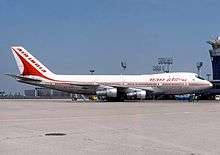Air India Flight 855
 VT-EBD, the aircraft involved, on New Year's Day 1976, exactly two years before the accident. | |
| Accident | |
|---|---|
| Date | 1 January 1978 |
| Summary | Spatial disorientation, and instrument malfunction; leading to confusion and loss of control |
| Site | Arabian Sea, near Mumbai, India |
| Aircraft | |
| Aircraft type | Boeing 747-237B |
| Aircraft name | Emperor Ashoka |
| Operator | Air India |
| Registration | VT-EBD |
| Flight origin |
Santacruz Airport Mumbai, India |
| Destination |
Dubai International Airport Dubai, United Arab Emirates |
| Passengers | 190 |
| Crew | 23 |
| Fatalities | 213 |
| Survivors | 0 |
Air India Flight 855 was a scheduled passenger flight that crashed during the evening of New Year's Day 1978 about 3 km (1.9 mi) off the coast of Bandra, Mumbai. All 213 passengers and crew on board were killed. The crash is believed to have been caused by the captain having become spatially disoriented after the failure of one of the flight instruments in the cockpit. It was Air India's deadliest aircraft crash until the bombing of Flight 182 in 1985. It was also the deadliest aviation accident in India until the Charkhi Dadri mid-air collision in 1996. As of 2018, Flight 855 is still the second deadliest aircraft crash in both of these categories.[1][2]
Aircraft and crew
The aircraft involved was a Boeing 747-237B,[note 1] registration VT-EBD, named Emperor Ashoka. It was the first 747 delivered to Air India, in April 1971.
The flight crew consisted of the following persons:
- The captain was 51-year old Mandan Lal Kukar. He had joined Air India in 1956, and had 18,000 flight hours.
- The first officer was 42-year-old Indu Virmani, a former Air Force commander who joined Air India in 1976. He had 4,000 flight hours.
- The flight engineer was 53-year-old Alfredo Faria, who joined Air India in 1955 and had 11,000 flight hours, making him one of Air India's most senior flight engineers at the time of the accident.[3]
Sequence of events
The departure was from Mumbai's Santa Cruz Airport (later Sahar Airport, now called Chhatrapati Shivaji Maharaj International Airport). The destination was Dubai International Airport in Dubai.[1][4]
Approximately one minute after takeoff from runway 27, Captain Kukar made a scheduled right turn upon crossing the Bombay coastline over the Arabian Sea, after which the aircraft briefly returned to a normal level position. Soon it began rolling to the left, and never regained level flight.
The cockpit voice recorder recovered from the wreckage revealed that captain Kukar was the first to notice a problem, when he said: "What's happened here, my instrument..." The captain was explaining that his Attitude indicator (AI) had "toppled", meaning that it was still showing the aircraft in a right bank. First officer Virmani, whose presumably functional AI was now showing a left bank (and not noticing the captain's concern), said "Mine has also toppled, look's fine." This indicated that his AI was also toppled, but there is some belief that the Captain mistakenly took this to mean that both primary AIs were indicating a right bank. It was after sunset and the aircraft was flying over a dark Arabian Sea, leaving the aircrew unable to visually cross-check their AI instrument readings with the actual horizon outside the cockpit windows.
The Boeing 747 had a third backup AI in the center instrument panel between the two pilots, and the transcripts of the cockpit conversation showed that the flight engineer Faria telling the captain "Don't go by that one, don't go by that one..." trying to direct his attention towards that third AI, or perhaps to another instrument called the turn and bank indicator, just five seconds before the aircraft impacted the sea.
The captain's mistaken perception of the aircraft's attitude resulted in his using the aircraft flight control system to add more left bank and left rudder, causing the Boeing 747 to roll further left into a bank of 108 degrees and rapidly lose altitude. Just 101 seconds after leaving the runway, the jet hit the Arabian Sea at an estimated 35-degree nose-down angle. There were no survivors among the 190 passengers and 23 crew members.[1]
Probable cause
The partially recovered wreckage revealed no evidence of explosion, fire, or any electrical or mechanical failure; and an initial theory of sabotage was ruled out.
The investigation concluded that the probable cause was pilot error; "due to the irrational control inputs by the captain following complete unawareness of the attitude as his AI had malfunctioned. The crew failed to gain control based on the other flight instruments."
US Federal District Judge James M. Fitzgerald, in a 139-page decision issued 1 November 1985, rejected charges of negligence against the Boeing Company, Lear Siegler Inc, and the Collins Division of Rockwell International Corporation in a suit related to the crash. It was dismissed in 1986.[4][5]
See also
- Sensory illusions in aviation
- John F. Kennedy, Jr., plane crash
- Other aircraft that crashed shortly after takeoff, while turning above a dark ocean:
- Other aircraft that crashed due to instrument malfunction:
Notes
References
- 1 2 3 Accident description for VT-EBD at the Aviation Safety Network
- ↑ Accident description for HZ-AIH at the Aviation Safety Network
- ↑ "April2017". Issuu. Retrieved 2018-04-30.
- 1 2 "Air India jet crashes just after takeoff - Jan 01, 1978 - HISTORY.com". HISTORY.com. Retrieved 2018-03-03.
- ↑ "Theory on Air India Crash Backed by a Pilot". The New York Times. 21 April 1985.
- Langewiesche, William (1998). "Chapter Four: On A Bombay Night". Inside the Sky: A Meditation on Flight. USA: Pantheon Books. ISBN 0-679-42983-2.
External links
- Design Induced Errors, which includes a discussion of the crash.
- Pre-crash photos of 747 VT-EBD at airliners.net